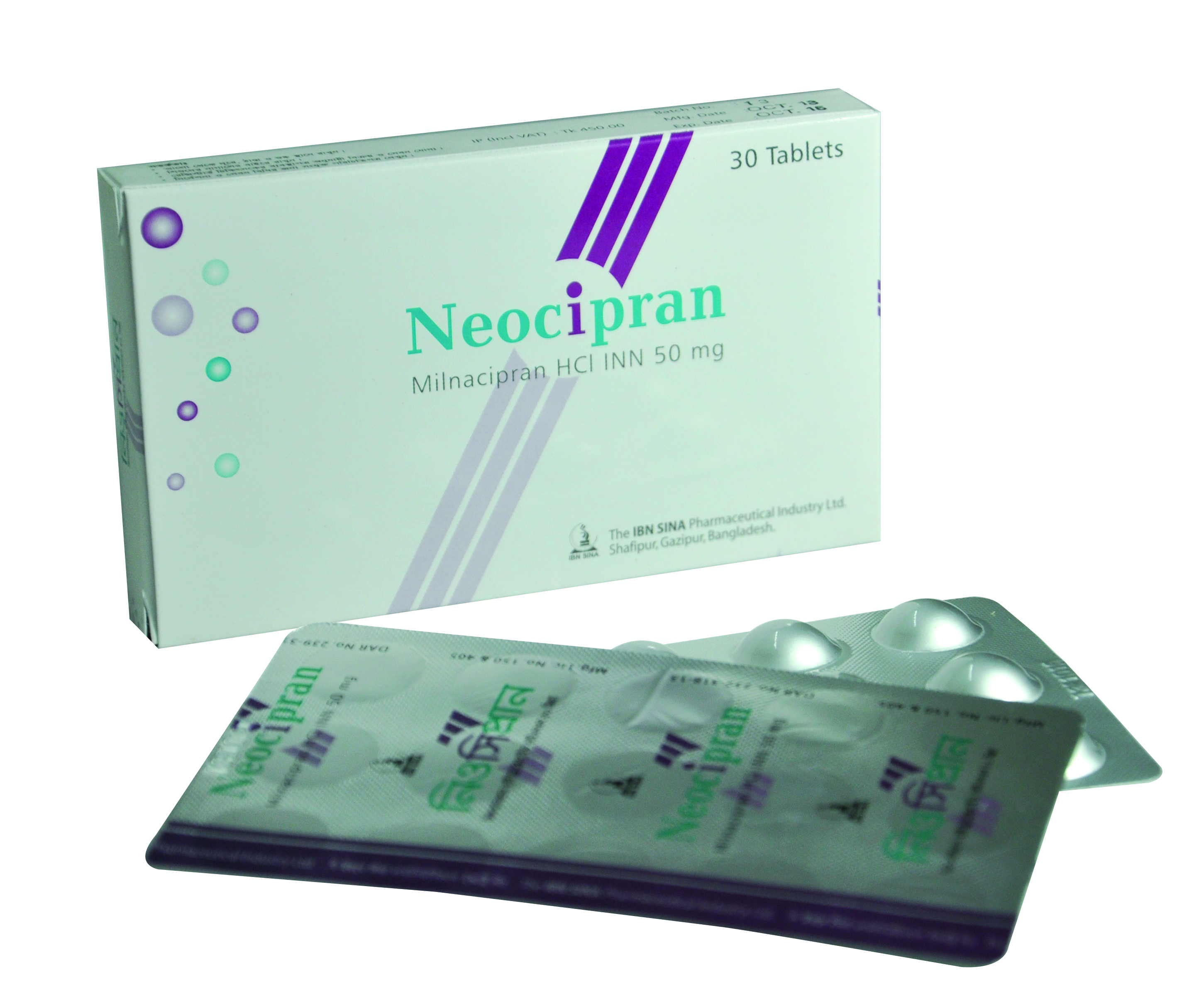
NEOCIPRAN
MILNACIPRAN HCI INN
| NAME | STRENGTH | PACK SIZE | DOSAGE FORM |
|---|---|---|---|
| NEOCIPRAN 50 MG TABLET | 50 MG | 30 S | TABLET |
Each film coated tablet contains Milnacipran HCI INN 50 mg.
Milnacipran is a potent inhibitor of neuronal norepinephrine and
serotonin reuptake in approximately 1:3 ratio respectively. These
actions simultaneously works synergistically to treat both depression
and fibromyalgia and also improve multiple fibromyalgia symptoms
such as peripheral and central pain, depressiveness, sleep and quality
Milnacipran HCI is indicated for the management & treatment of major depressive disorder (MDD), post-stroke depression, depression following mild and moderate traumatic brain injury (TBI), co-morbid depression in diabetes, peripheral neuropathy and fibromyalgia in adults. It is not approved for use in pediatric patients.
The recommended dose of Milnacipran HCI is 100 mg/day (50 mg twice daily). Based on efficacy and tolerability dosing may be titrated according to the following schedule: Day 1:12.5 mg once
Days 2-3:25 mg/day (12.5 mg twice daily)
Days 4-7:50 mg/day (25 mg twice daily)
After Day 7: 100 mg/day (50 mg twice daily). Based on individual patient response, the dose may be increased to 200 mg/day (100 mg twice daily). Doses above 200 mg/day have not been studied.
Concomitant use of Milnacipran in patients taking monoamine oxidase inhibitors (MA01s) is contraindicated. In patients receiving a serotonin reuptake inhibitor in combination with a monoamine oxidase inhibitor (MAGI), there have been reports of serious, sometimes fatal, reactions including hyperthermia, rigidity, myoclonus,autonomic instability with possible rapid fluctuations of vital signs, and mental status changes that include extreme agitation progressing to delirium and coma. In clinical trials, Milnacipran was associated with an increased risk of mydriasis. It should not be used Milnacipran in patients with uncontrolled narrow-angle glaucoma.
Milnacipran is a selective serotonin and norepinephrine re-uptake inhibitor (SNRI), similar to some drugs used for the treatment of depression and other psychiatric disorders. Patients both adult and pediatric, with depression or other psychiatric disorders may experience worsening of their depression and/or the emergence of suicidal ideation and behavior (suicidality) or unusual changes in behavior, whether or not they are taking these medications, and this risk may persist until significant remission occurs. All patients being treated with drugs inhibiting the reuptake of norepinephrine and/or serotonin for any indication should be monitored appropriately and observed closely for clinical worsening, suicidality, and unusual changes in behavior, especially during the initial few months of a course of drug therapy, or at times of dose changes, either increases or decreases. The development of a potentially life-threatening serotonin syndrome or Neuroleptic Malignant Syndrome (NMS)-like reactions have been reported with SNRIs and SNRIs alone, including Milnacipran, but particularly with concomitant use of serotonergic drugs (including triptans), with drugs which impair metabolism of serotonin (including MA01s) or with antipsychotics or other dopamine antagonists. Serotonin syndrome symptoms may include mental status changes (e.g., agitation, hallucinations, coma), autonomic instability (e.g., tachycardia, hyperthermia), neuromuscular aberrations (e.g., hyperreflexia, incoordination) and/or gastrointestinal symptoms (e.g., nausea, vomiting, diarrhea). Milnacipran have been associated with reports of increase in blood pressure.
The most frequently occuring adverse reactions were nausea, headache, constipation, dizziness, insomnia, hot flush, hyperhidrosis, vomiting, palpitations, heart rate increased, dry mouth and hypertensions.
Milnacipran has not been adequately studied in pregnant women, however, the full risks are not known. When the drug was given to pregnant rats, it increased the risk of fatal death. Milnacipran is considered a pregnancy category C medication. It may be given to a pregnant woman if the Physician believes that the benefits to the woman outweigh any possible risks to the unborn child.
Milnacipran undergoes minimal CYP450 related metabolism, with the majority of the dose excreted unchanged in urine (55%), and has a low binding to plasma proteins (13%). In vitro and in vivo studies showed that Milnacipran is unlikely to be involved in clinically significant
Speciifc information not available.
Store in a cool and dry place. Keep away from light and out of reach of children.
Each commercial box contains 2 x 15's tablets in blister packing.
